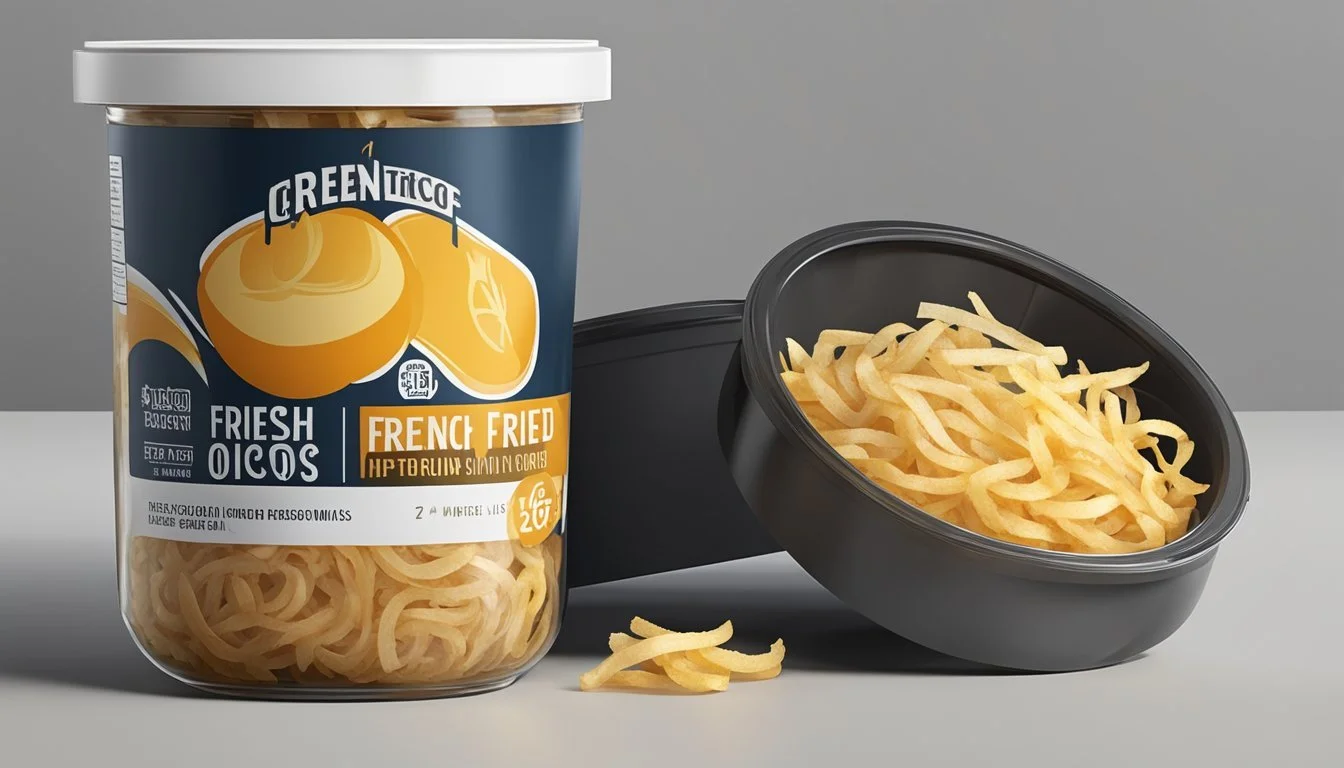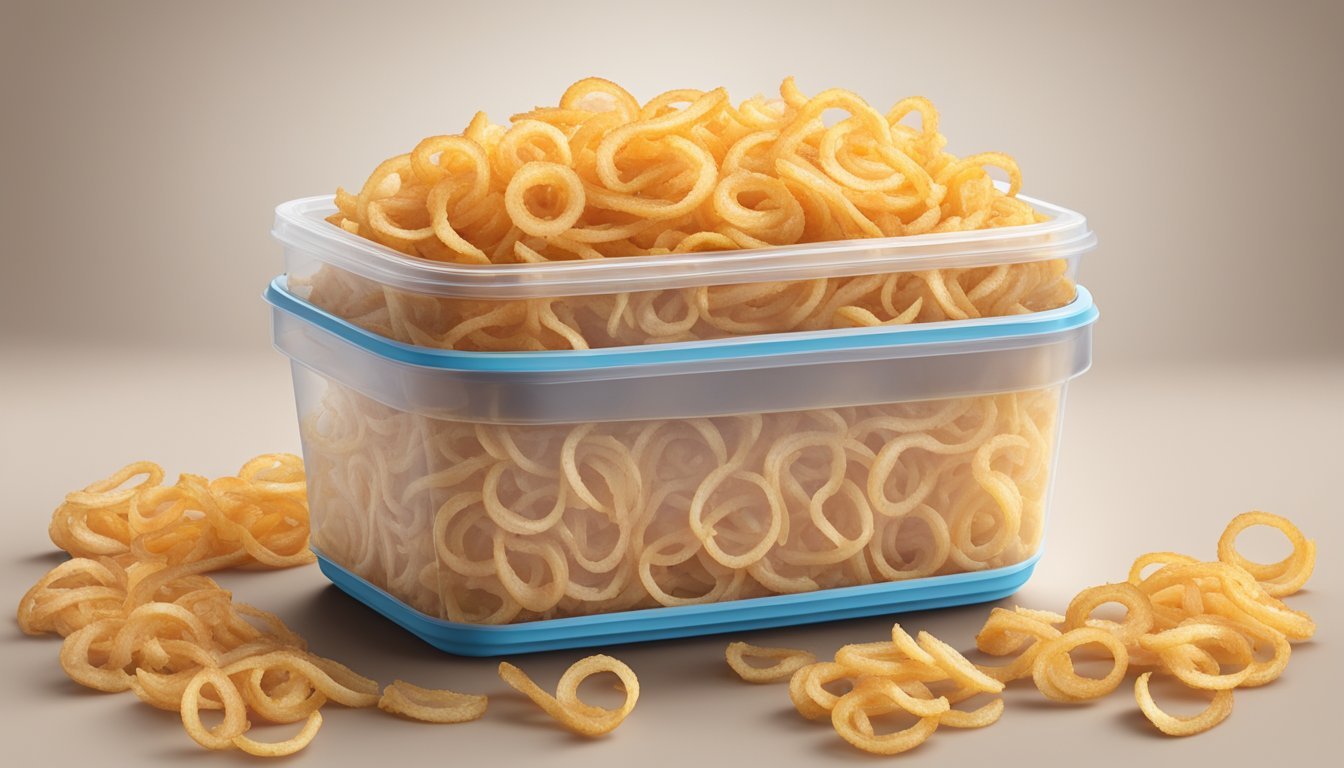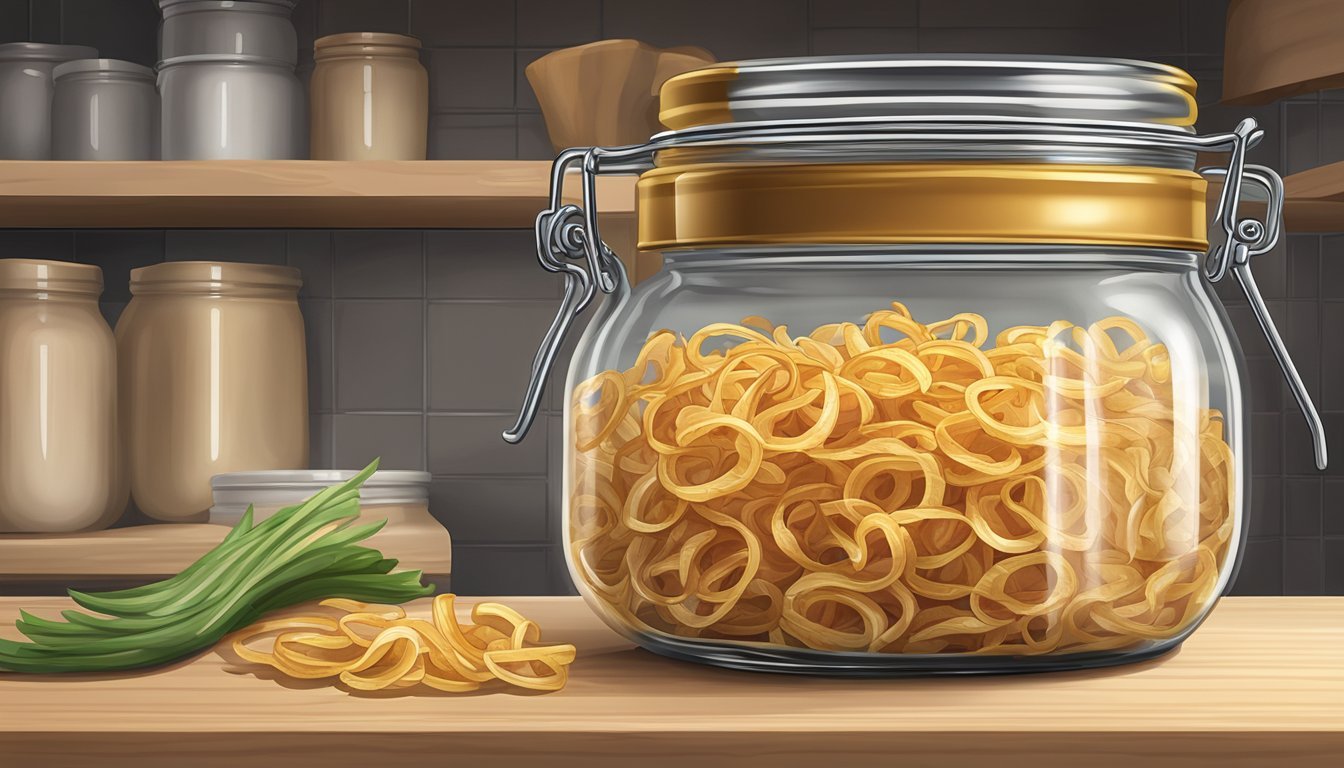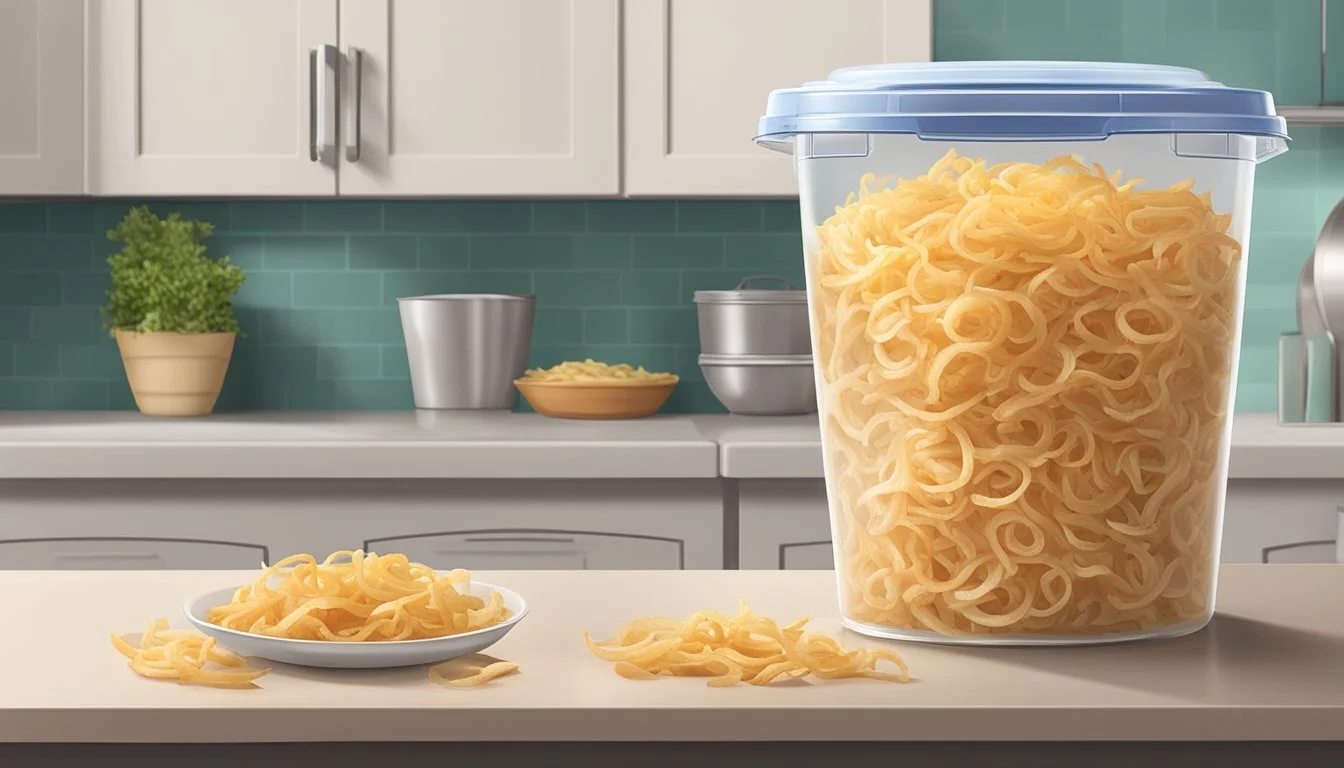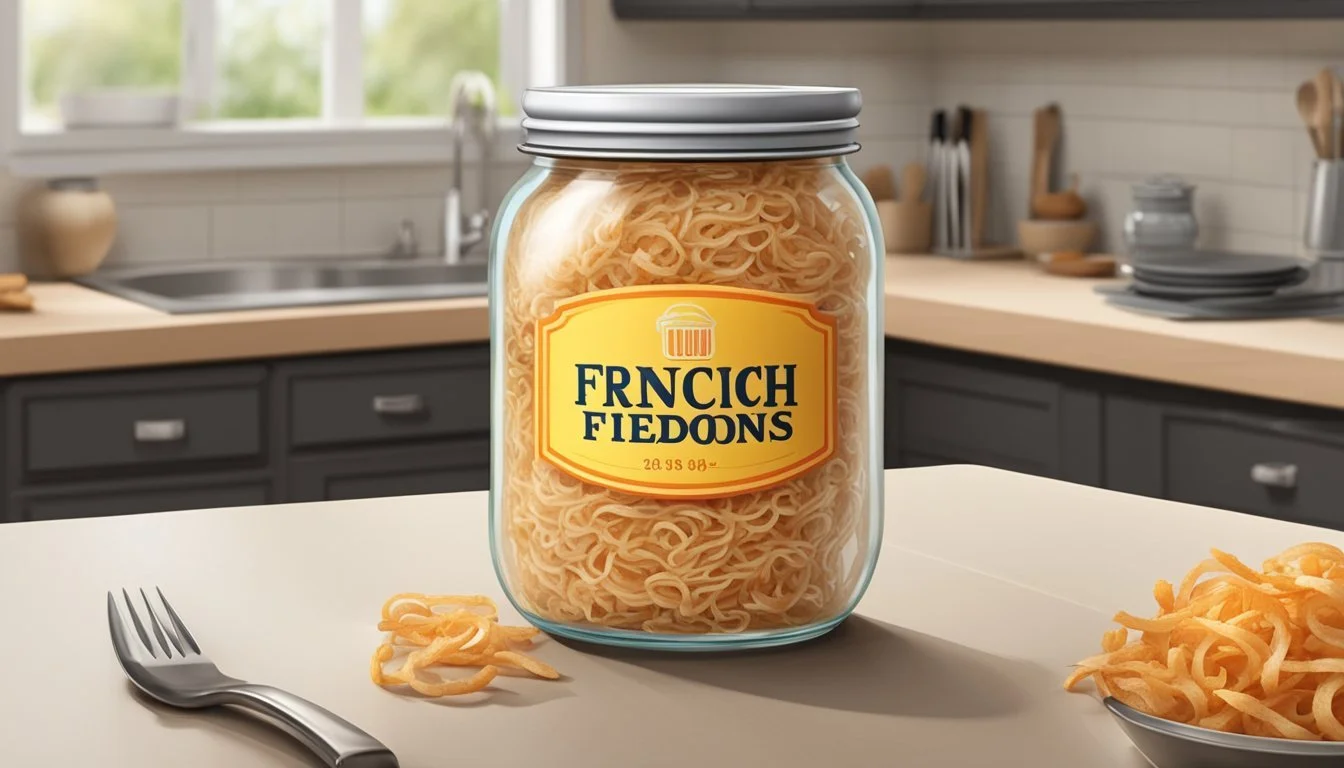How Long Do French Fried Onions Last?
Shelf Life and Storage Tips
French fried onions (What wine goes well with onions?) add a delightful crunch and flavor to many dishes, often serving as a garnish for classics like green bean casserole. Understanding the shelf life of French fried onions is essential in ensuring flavor and quality, as well as food safety. Typically, French fried onions come with a 'best by' date printed on their packaging, which indicates the time frame within which they can be expected to retain their optimal taste and texture.
Upon opening, the shelf stability of French fried onions can be influenced by various factors, such as storage conditions. When stored correctly in a cool, dry place, they can remain fit for consumption from anywhere up to 6 to 8 weeks. The crispy texture is best preserved when exposure to moisture and heat sources, which can hasten spoilage, is minimized.
Manufacturers like French's suggest that their product remains safe to consume for 18 months from the date of manufacture. Consumers may still opt to use French fried onions past their 'best by' dates, though there may be a decline in quality. However, it's important to evaluate the condition of the onions before use, as any signs of spoilage should be heeded to avoid potential health risks.
Understanding French Fried Onions
French fried onions, a popular garnish and ingredient, are made from real onions that have been minced, battered, and deep-fried until they achieve a golden, crispy texture. They are renowned for adding a savory, umami-rich flavor to dishes, with their crispy texture providing a pleasant contrast in recipes like green bean casserole, salads, and soups.
Ingredients and Dietary Notes:
Main Ingredient: Onions
Batter Components: Typically flour (contains gluten), seasoning
Cooking Oil: Often palm or vegetable oil
Given that the primary ingredient is onions and the batter generally contains wheat flour, French fried onions are not inherently gluten-free. This is important for individuals with gluten sensitivities or celiac disease to note. Moreover, the use of certain oils and potential involvement of non-vegan additives in the batter could make them unsuitable for vegan diets. Shoppers with dietary restrictions should look for specially labeled gluten-free or vegan brands.
Taste and Use: The flavor of French fried onions is a balance between the sweetness of onions and the savory notes from salt and other seasonings. Their use extends beyond mere garnishing; they can act as a key flavor component in recipes.
Storing French Fried Onions:
Storage Condition Expected Shelf-life Unopened, Pantry Several months Opened, Cool & Dry Pantry 6 to 8 weeks Opened, Refrigerator (airtight container) 2-3 days
Informed storage practices are crucial to maintain their taste and crispy texture. Once opened, keeping them in a cool, dry place or refrigerated in an airtight container is recommended to extend their shelf life and preserve quality.
Shelf Life Fundamentals
When assessing the shelf life of French fried onions, consumers should distinguish between the 'best by' date and the actual expiration. The 'best by' date relays the manufacturer's estimate of when the product will remain at peak quality. In contrast, expiration dates are related to food safety. Generally, the shelf life for this product is 18 months from the date of manufacture.
French fried onions retain freshness if they are kept in proper storage conditions. Consumers are advised to store the product in a cool, dry place, away from direct sunlight or heat sources, to preserve their quality and taste. If packaging is opened, it's essential to seal it tightly after each use.
Should someone encounter expired French fried onions, decision on whether to consume should be based on a quality check. Signs of spoilage include:
Loss of crispness
Discernible change in color
Off smell
Below is a simplified guide to the shelf life and storage conditions:
State Shelf Life Storage Condition Unopened Up to 18 months Cool, dry place Opened Approx. 3-4 months Sealed container, dry place
It is critical to note that while the product may not necessarily be harmful after the 'best by' date, the sensory qualities such as flavor and crunchiness may diminish over time. Therefore, timely consumption is key to enjoying the product's intended taste and texture.
Assessing Freshness
When determining the freshness of French fried onions, one must consider several factors such as appearance, smell, and texture which are indicators of whether the onions are still good to consume or have gone bad.
Visual and Olfactory Indicators
French fried onions should retain a golden-brown color; any discoloration may indicate spoilage. In terms of smell, they should have a savory aroma. An absence of this aroma or the presence of odd odors such as mustiness can be a sign of spoilage.
Texture and Crispiness
Fresh French fried onions typically have a crispy and crunchy texture. If they feel soft or limp, it suggests a loss of freshness. The crispiness is a key aspect of their appeal, and any deviation from this texture could render the onions less palatable and potentially stale.
Signs of Spoilage
The telltale signs of spoilage in French fried onions include:
Mold: Visible growth of mold signifies bacterial activity and spoilage.
Off smell: Any sour or rancid odor indicates that the onions have gone bad.
Taste: A change in flavor, such as bitterness, could mean the onions are no longer fresh.
Texture: A soggy or chewy texture is a clear sign that the onions have lost their crunchiness and should be discarded.
Proper Storage Techniques
Ensuring the longevity of French fried onions relies heavily on the execution of proper storage techniques. These techniques regulate temperature, air exposure, and moisture to maintain the product's crispiness and flavor.
Temperature and Humidity Control
Optimal storage conditions for French fried onions necessitate a cool, dry place such as a pantry or cupboard away from sources of heat and moisture. Temperature and humidity levels should be controlled to prevent the onions from becoming soft or moldy.
Container Selection
For maintaining freshness, French fried onions should be kept in an airtight container or resealable bag. Containers made of glass, metal, or plastic with a secure lid are ideal. This prevents air and moisture from spoiling the onions.
Refrigeration vs. Pantry
It's recommended to store the container of French fried onions in the pantry for short-term use. If long-term storage is needed, placing them in a freezer-safe container and storing them in the refrigerator or freezer can extend their shelf life and preserve their quality.
Extending Shelf Life
To maximize the shelf life of French fried onions, proper storage techniques such as freezing and the use of preservatives are essential. These methods can significantly prolong the freshness and quality of the onions.
Freezing and Thawing
French fried onions can be preserved for longer by storing them in the freezer. It's important to use freezer-safe containers or bags to protect them from freezer burn and to preserve their flavor and texture. Ideally, the temperature of the freezer should be maintained at 0°F (-18°C) to ensure the onions remain fresh for an extended period. When it comes to thawing, it should be done at room temperature for a few minutes before use.
Table: Freezing French Fried Onions
Step Description 1 Transfer to a freezer-safe container. 2 Seal the container to prevent air entry. 3 Label with the current date. 4 Keep at a constant 0°F (-18°C) 5 Thaw at room temperature when needed.
Utilizing Preservatives
Adding preservatives can aid in extending the shelf life of French fried onions that are not frozen. Common preservatives include salt, flour, and oil which help by reducing moisture and providing a barrier against spoilage. Storing the onions in airtight containers, where the humidity and temperature are controlled, can also help to keep them fresh for a longer time.
List of natural preservatives:
Salt
Vinegar
Rosemary extract
By following these storage techniques, the shelf life of French fried onions can be extended, preserving their quality and taste.
Usage in Cooking and Meals
French fried onions offer a unique combination of crunch and savory flavor that can elevate the taste and texture of various dishes. They are a versatile ingredient used to add a delightful crispiness to recipes, serve as an appealing topping or garnish, and provide creative pairing options for meals with unique dietary requirements.
Incorporation in Recipes
French's fried onions can be seamlessly incorporated into numerous recipes to enhance their flavor profile. Casseroles (What wine goes well with casseroles?), such as the classic green bean casserole, utilize these onions to create a textural contrast with the creamy base. Additionally, they can be mixed into burger patties or sprinkled onto a pizza before baking to add a crispy, flavorful element.
Burgers: Mix chopped French fried onions into ground meat for an added crunch.
Pizzas: Sprinkle on top before baking to infuse a savory onion flavor.
Toppings and Garnishes
French's Crispy Fried Onions are a popular choice for topping off salads, soups, and hot dogs, providing an instant upgrade with their distinctive crunchiness. As a garnish, they add not just flavor but also a visual appeal to the meals.
Salads: Toss onto greens for a delicious textural addition.
Soups: Offer a delightful crispiness when sprinkled on top before serving.
Unique Pairings and Substitutes
These fried onions can be used in creative ways to pair with both traditional and unconventional dishes. For those who prefer homemade or alternative options, making a gluten-free or vegan version can serve as an excellent substitute without compromising on the desired taste and crispiness.
Homemade Substitutes: Utilize gluten-free or vegan ingredients to cater to dietary restrictions.
Creative Pairings: Try them with unique dishes for an unconventional twist.
Dietary Adaptations
French fried onions can also fit into various diet plans with a little adaptation. Those requiring gluten-free options might opt for alternatives made from gluten-free flour, while vegan versions avoid any animal products, ensuring everyone can enjoy the savory addition of fried onions in their cooking.
Gluten-Free: Look for or prepare options that use gluten-free flour.
Vegan: Ensure the ingredient list complies with vegan dietary choices.
Commercial Products Overview
When examining commercial French fried onions available on the market, it's essential to consider the different brands and varieties, understand the labeling and expiration dates, and recognize any dietary and allergy information that may be relevant to consumers.
Brands and Varieties
Commercially, a variety of brands produce French fried onions, with French's Crispy Fried Onions being one of the most well-known. These crunchy toppings can be found in the aisle of most grocery stores and come in various packaging sizes suited for different culinary needs. Some companies may offer additional flavors or styles to enhance dishes.
Label and Expiration Information
On the packaging of these products, consumers will typically find a "best by" date. This is not an expiration date but rather the manufacturer's recommendation for peak quality. Most brands, such as French's, suggest a shelf life of 18 months from the date of manufacture. After opening, the product's freshness can be expected to last 6 to 8 weeks if properly stored in a cool, dry place.
Dietary and Allergy Information
For individuals with dietary restrictions, it's important to review the packaging for relevant information. For instance, some French fried onions, like other products, may be labeled as gluten-free or may contain allergens. Packaging will often include this information to assist customers in making informed decisions in line with their dietary needs.
Everyday Applications
French fried onions serve as a versatile ingredient, enhancing flavor with their crispy texture. They are commonly used to add a crunchy element to dishes and intensify the taste experience.
Snacking and Casual Eating
For snacking purposes, they can be a delicious and crunchy addition. People often enjoy them straight out of the container for a quick and filling snack. Their unique taste and texture make them an enjoyable snack that's easy to incorporate into everyday eating.
Picnics and Outdoor Events
At picnics and outdoor events, these onions act as a flavorful topping that can be effortlessly sprinkled over salads, hot dogs, or burgers. Their ability to maintain a crunchy texture adds an enjoyable contrast to these dishes, even when incorporated with leftovers.
Salads: Adds a crispy texture as a topping.
Burgers/Hot Dogs: Enhances the overall flavor and crunch.
Quick Meal Enhancements
French fried onions are a perfect addition to quickly elevate the taste of home-cooked meals. Whether mixed into casseroles, sprinkled on top of green beans, or added to a potato dish, they infuse a savory flavor and crunch that can make an ordinary meal feel more special. They are especially popular during holidays as a topping for classic green bean casseroles.
Casseroles: Create a delicious and crispy top layer.
Potatoes: Provide a savory crunch.
Green Beans: Upgrade the dish with a crunchy texture and flavor.
Handling Leftovers
When dealing with leftovers of French fried onions, proper storage is key to maintaining their taste and crispiness. They should be refrigerated within two hours of serving to prevent spoilage. To maximize freshness, leftovers should be placed in a sealed, airtight container. This prevents exposure to air and moisture, which can lead to staleness.
Refrigeration Guidelines:
Temperature: Store below 40°F (4°C)
Container: Airtight to prevent moisture
Location: Away from raw foods to avoid contamination
Leftovers can generally be enjoyed for up to 4 days when stored correctly in the fridge. It’s crucial to avoid placing the container near any strong-smelling foods, as the onions can absorb odors which may affect their taste.
Quick Check Tips:
Look: Check for any visible mold or discoloration.
Smell: Sniff for off-odors.
Taste: If in doubt, taste a small amount before deciding to consume.
If the French fried onions develop an off smell, taste, or appearance, they should be discarded for safety. Remember to always trust your senses before deciding to consume any leftovers.
Health and Nutritional Aspects
When considering the nutritional aspects of French fried onions, they are known to contain calories, fat, and sodium. They are not typically categorized as a health food due to their being fried and often containing added preservatives for shelf stability. The main ingredient, onions, does provide some dietary fiber and essential nutrients.
Here's a basic nutritional profile for French fried onions:
Calories: Typically high due to frying and oil absorption
Fat: Contains saturated and unsaturated fats, the amount varying by brand
Sodium: Can be substantial, as salt is used for flavoring and preservation
Fiber: Onions provide dietary fiber, beneficial for digestion
When it comes to health considerations, French fried onions should be consumed in moderation, especially for individuals with dietary restrictions related to fat or sodium intake. They are generally more of a garnish or topping than a standalone food and are best enjoyed as part of a balanced diet.
Consumers looking for healthier options can seek out brands that use minimal ingredients without added preservatives or explore homemade alternatives using healthier cooking methods. Baking instead of deep frying, for instance, can reduce the fat content significantly.
It is important that individuals with any dietary concerns read the nutritional labels carefully to understand the portion size and what constitutes a serving. This can help them incorporate French fried onions into their diet in a way that aligns with their nutritional goals and needs.
Frequently Asked Questions
This section addresses common queries related to the longevity and usage of French fried onions, providing clear storage and application advice for optimal freshness.
Preservation FAQs
Can one freeze French fried onions to ensure a longer shelf life? Yes, French fried onions can be frozen to extend their shelf life. They maintain freshness for up to six months when stored in an airtight, freezer-safe container or bag.
Is refrigeration necessary after opening French fried onions? While not required, refrigeration can help keep French fried onions fresh. Seal them tightly and store in the refrigerator to preserve for approximately two weeks.
Usage FAQs
Could French fried onions, once opened, still be used as a topping beyond two weeks? French fried onions are often used as a crunchy topping on casseroles and other meals. If stored correctly in an airtight container, they can be used beyond the two-week mark as long as they remain crisp and are not past their expiration date.
In what other ways can French fried onions be included in meals?
They are a versatile addition that can enhance the flavor profile of various dishes, from snacks to main courses, providing an extra texture and taste that complements many recipes.





